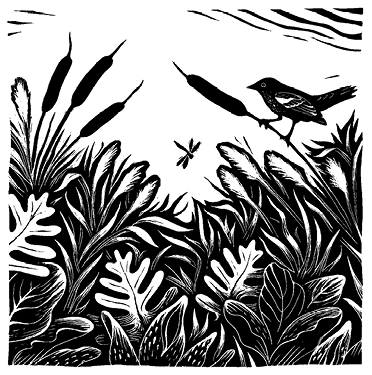Children of the Reeds:
Adventures in a
Not-So-Imaginary Place
Linda Raedisch
An ordinary place exists only on the map, while a sacred place exists half in the imagination. It’s a little more difficult to say what sets a sacred place apart from an imaginary place. Perhaps the difference exists only in the imagination. My own sacred place exists within the Great Swamp of north central New Jersey. It was at the newly developed edge of these wetlands that one of the most mysterious encounters of my life took place, though I did not see it as mysterious at the time.
I was about four years old, an age at which much of life is still a mystery. When I think of my early childhood, the swamp looms large: the sibilant rustling of Phragmites—around here the common reed goes by its taxonomic name—and the pungent blue burning of my father’s cigar, which, he told me, he smoked to keep the deer flies and mosquitoes at bay. In those days, I liked nothing better than to pack a bag of peanut butter sandwiches and walk with him along one of the dirt roads that ran the length of “our” stretch of swamp. At one end of the road was the busy thoroughfare leading to my sister’s school, and at the other, a housing development in the throes of construction. Even from deep in the reeds you could hear the clatter of hammers and the raw ringing of power saws. The houses going up were much larger than ours: four and five bedrooms with dressing rooms, playrooms, and dens. A few were already lived in, while others were mere frameworks open to the sky.

The streets themselves were brand-new too, and it was while exploring the freshly tarred Crocodile Drive that I spotted the children: a brown-haired girl and a brown-haired boy, both about my own age, playing in a sandbox installed among the rust brown rocks and swamp clay of their desolate new yard. We regarded one another in silence. They did not ask me to stop and play, nor was I sure I wanted them to. Soon, my father and I had passed on up the hill to return home along the shoulder of the main road.
Those children held a strange fascination for me. I did not go to nursery school and had no neighbors my own age. My sister, three and a half years older, was a creature of a much higher order and always seemed to be in school. Most days, children simply weren’t on the menu, so I was eager to get another glimpse of those sandbox kids. Couldn’t we take another walk down Crocodile Drive?
Where?
Crocodile Drive!
No such street. My father and I continued to include the development in our swampy ramblings, but there simply was no Crocodile Drive, only hard-packed earth and a thicket of native laurel where the children and the sandbox should have been. I was not overly troubled by this state of affairs at the time, not with so many other mysteries to occupy my growing mind. Eventually I, too, got to go to school; not the old brick school where my sister had started but the new open-plan experiment through whose large, paneless windows I could look down on my old stomping grounds, at the hummocks, the purple-horned skunk cabbages, and the occasional flash of a red-winged blackbird’s epaulette among the Phragmites.
I learned about places far beyond my swamp, places impossibly distant in time and space. In seventh grade, I developed a fascination for all things ancient, especially the civilization of Sumer. Had I expressed this fascination more openly, and had life been a little different, there might have been trips to museums and libraries to see the artifacts close up, to learn more. But life was not like that, and my love for ancient Sumer remained an intensely personal matter, as personal as my love for the swamp.
And, for a time, my swamp became Sumer. The cracked clay deposits in the ruts of the dirt paths provided the clay with which the first scribe (me!) formed the first cuneiform tablets. The brown, slow-moving streams became the Tigris and Euphrates. The feathery stands of Phragmites along their banks were the reed thickets of Eridu, site of the world’s first city. I gave little thought to the fact that at the same time my swamp was becoming my Sumer, Sumer itself was a land lost to time, its brick temples eroded to soft mounds, the reed thickets silted up with salt and sand.

Once upon a time, that land between two rivers had been an eden, the Eden, for eden was the Sumerian word for the fertile alluvial plain on which they built their cities. For the Sumerians, it was simply home. The Sumerian paradise, on the other hand, was a land called Dilmun, a place of eternal life and freedom from suffering, a sacred realm where “the raven utters no cry.” In the 1960s, it was discovered that Dilmun was also a real place, a civilization on a par with those of Mesopotamia and centered on the island of Bahrain. Dilmun, then, like my own personal Sumer, was both a place you could point to on a map and one that existed only on the plains of the imagination.
I no longer live within earshot of those whispering Phragmites; I’m about a five-minute drive from that dirt service road, and, I have to admit, I no longer visit all that often. And yet I’m always aware of where I am in relation to the swamp. In the early afternoon, when the sun first shines from the direction of the swamp, I find myself stopping in the patch of light falling through the window as if to say hello. I’ve since had adventures much further afield and in far more impressive landscapes, but the swamp remains my sacred place and I think I will never live far from it, at least not for long.
And what about Crocodile Drive? Over the years, a few more roads have made incursions into the reeds and laurel thickets. I’ve walked up and down them and none of them is Crocodile Drive. It was not until about ten years ago, after I had embarked on the study of the folklore of fairies, that I began to view the sandbox children in a different light. Like the old-time “good people,” or fairies, they had looked perfectly ordinary, were of a higher station than I was, had appeared on the border between wilderness and human settlement, and had disappeared without a trace. I’ll never know exactly who or what they were, but I sometimes wonder if I presented as much of a mystery to them as they did to me. Perhaps, even now, one of them is composing an essay about the time they saw a pale blond fairy child emerge from the swamp, stroll past the yard, then vanish into thin air …
Linda Raedisch is the author of The Old Magic of Christmas: Yuletide Traditions for the Darkest Days of the Year (Llewellyn, 2013) as well as numerous articles on folklore, ethnobotany, archaeology, and religion. She is currently at work on a book about the origins of the witch figure. You can find her on Facebook or simply look for the house with the witch’s hat on the lamppost.
Illustrator: Neil Brigham